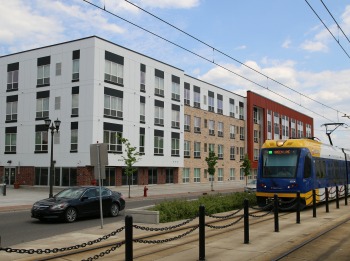
Hamline Station was designed with future environmental impact and sustainability at the forefront of all activities of the project. Urban sites such as the former Midway Chevrolet site, historically can be redevelopment nightmares because of the need for remediation and regulatory complexity. Fortunately for Hamline Station, AET kept the project moving smoothly forward. They worked closely with the MPCA and other regulatory agencies to create a Response Action Plan (RAP) for site remediation that not only benefited the site but the surrounding areas. Anderson Companies working with AET, was able to provide guidance from before the official groundbreaking to the final day of construction.
The primary goals of the RAP were to identify, characterize, excavate, and properly dispose of contaminated soils exceeding the industrial-use cleanup goals for PAHs and DRO and to successfully satisfy the requirements for issuance by the MPCA VIC Program of “No Further Action” and “No Association Determination” for all interested parties. The RAP incorporated a combination of hot spot soil removal (where readily achievable) and management/disposal of soils with petroleum impacts or other low-level impacts were encountered during site preparation. Hot spots were defined as areas where measured contaminant concentrations exceeded the assigned response action goals for the intended site use. Soils were screened and confirmation soil samples were collected from beneath the two underground storage tanks (UST).
The entire soil excavation process was observed and monitored by AET’s field technicians. During the excavation, soil samples were collected directly from the backhoe bucket or excavation site and were observed for obvious visual or odor indications of contamination and screened with a photoionization detector (PID) for the presence of organic vapors. The field screening results and observations were used to document where response action goals have been attained and to segregate impacted materials for appropriate disposal streams. Performing these screenings helped reduce the amount of hauling needed for new soils, reducing the environmental impact of construction.
Alongside the soil excavation screenings, AET performed particulate air monitoring during the first week of excavation activities to document acceptable levels of dust generation, conducting daily observations and collecting particulate samples to monitor the amount of dust to reduce the impact on the mostly residential neighbors. The samples were analyzed for polynuclear aromatic hydrocarbons (PAHs) and lead. A total of 14,561 tons of contaminated soils were excavated and disposed at the landfill. Based on a generic factor of 1.4 tons-per-cubic-yard, the estimated volume of contaminated soil disposed was approximately 10,400 cubic yards.
Hamline Station is a great example of people, passion and partnerships coming together to address significant community and economic issues. Project for Pride in Living (PPL) promoted economic development, sustainability, and community livability by remediating environmental contamination on this long-blighted property and created large-scale affordable housing along the Green Line Light Rail Corridor in the Midway neighborhood of St. Paul, Minnesota.
This project was awarded an Honor Award from ACEC/MN for Environmental Engineering. For more information on AET’s Environmental Services contact Vice President Environmental Services Gail Cederberg, PhD and visit our services page.



